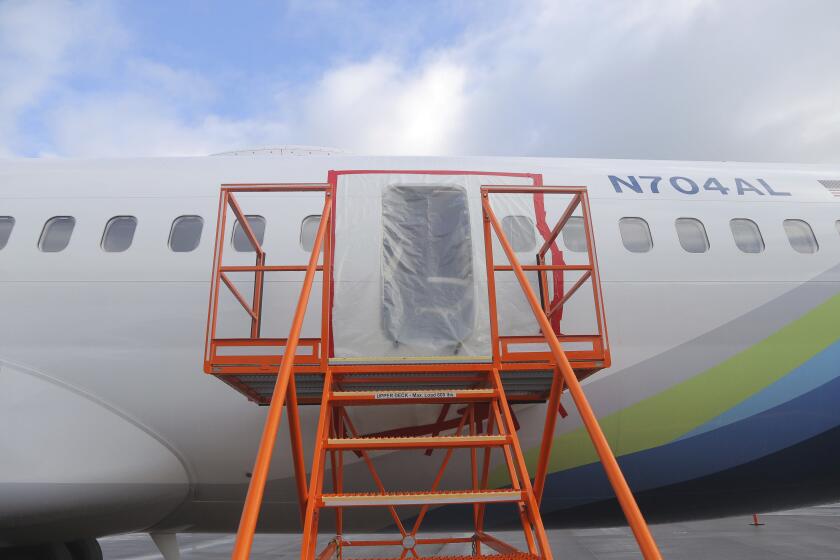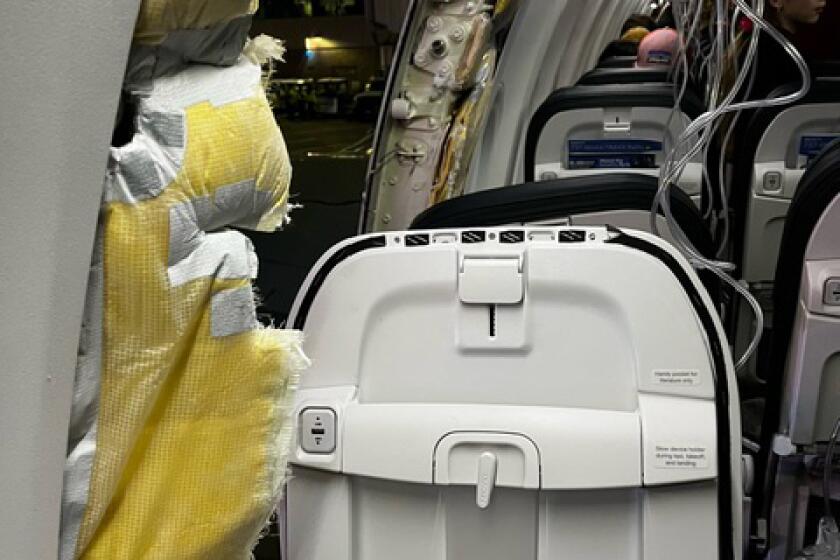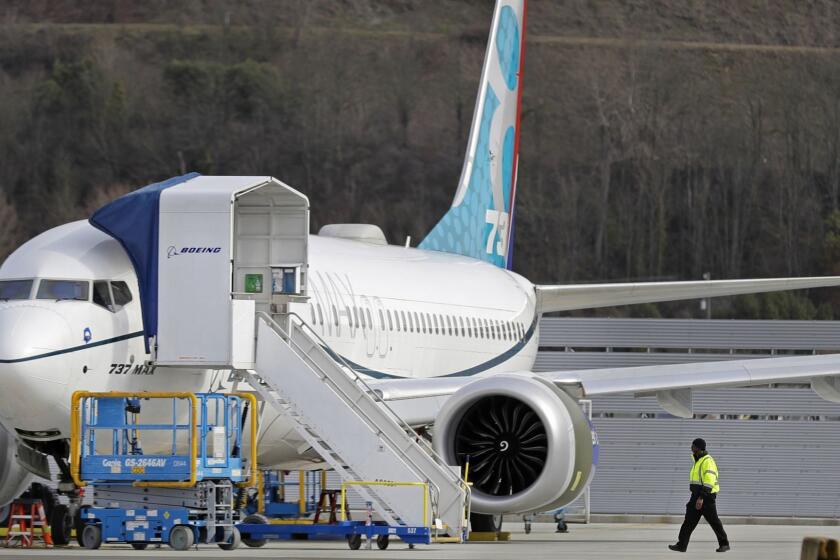Boeing 737 Max 9 plane that lost door plug was missing bolts, NTSB says
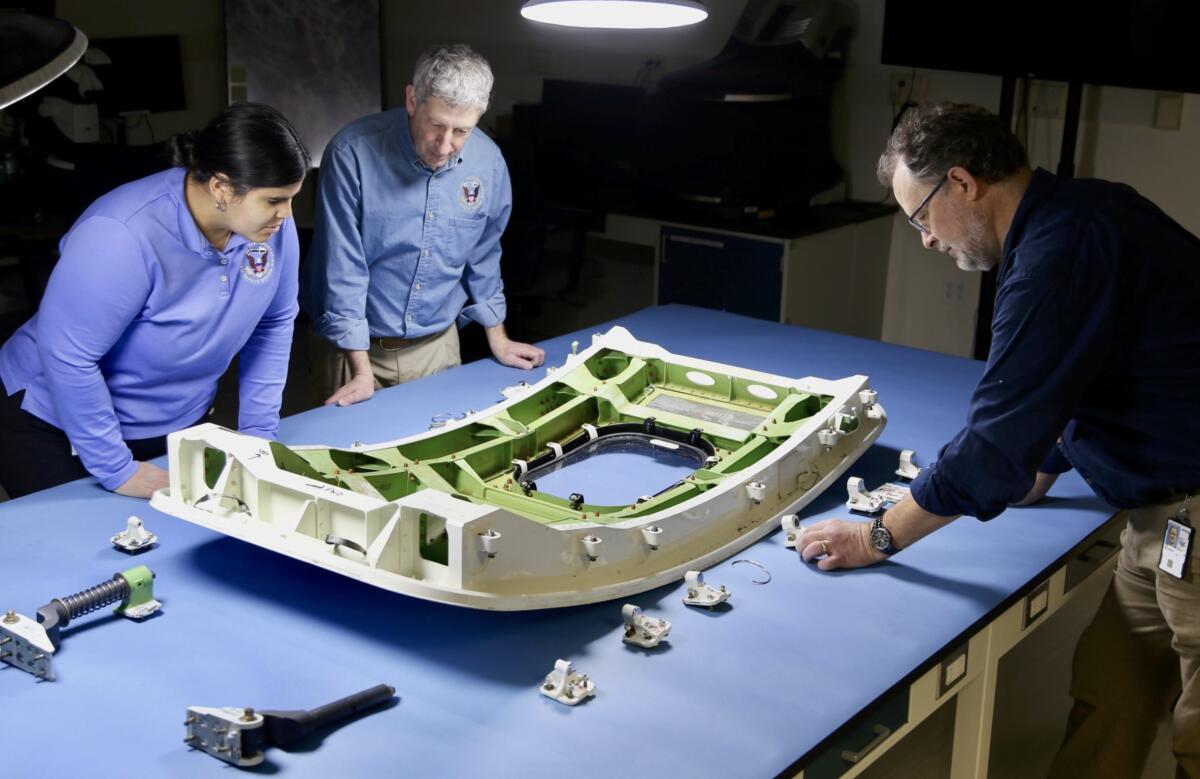
- Share via
Four bolts were missing from a door panel that blew out of an Alaska Airlines flight last month while the Boeing 737 Max 9 plane was flying over Oregon, according to a preliminary report from the National Transportation Safety Board.
The bolts are there to prevent the non-operational panel, known as a door plug, from moving upward, the NTSB said. But last year, before the plane was delivered to Alaska Airlines, the door panel had to be opened and four bolts removed at Boeing’s Renton, Wash., factory to replace damaged rivets nearby, the report says.
As part of the investigation, the agency found that the “absence of contact damage or deformation” around holes associated with vertical movement bolts indicates that four bolts of the door panel were missing before the panel moved up off the stop pads, according to the report.
It’s unclear why the bolts were missing. Records show that the rivets were replaced, but photos obtained from Boeing Co. by the NTSB show that the door panel was put back without bolts in three visible locations. The fourth location is obscured in the photo by insulation, the NTSB said.
The photo of the door panel came from a text message between Boeing employees who were discussing “interior restoration after the rivet rework was completed during second shift operations that day,” the NTSB’s report says.
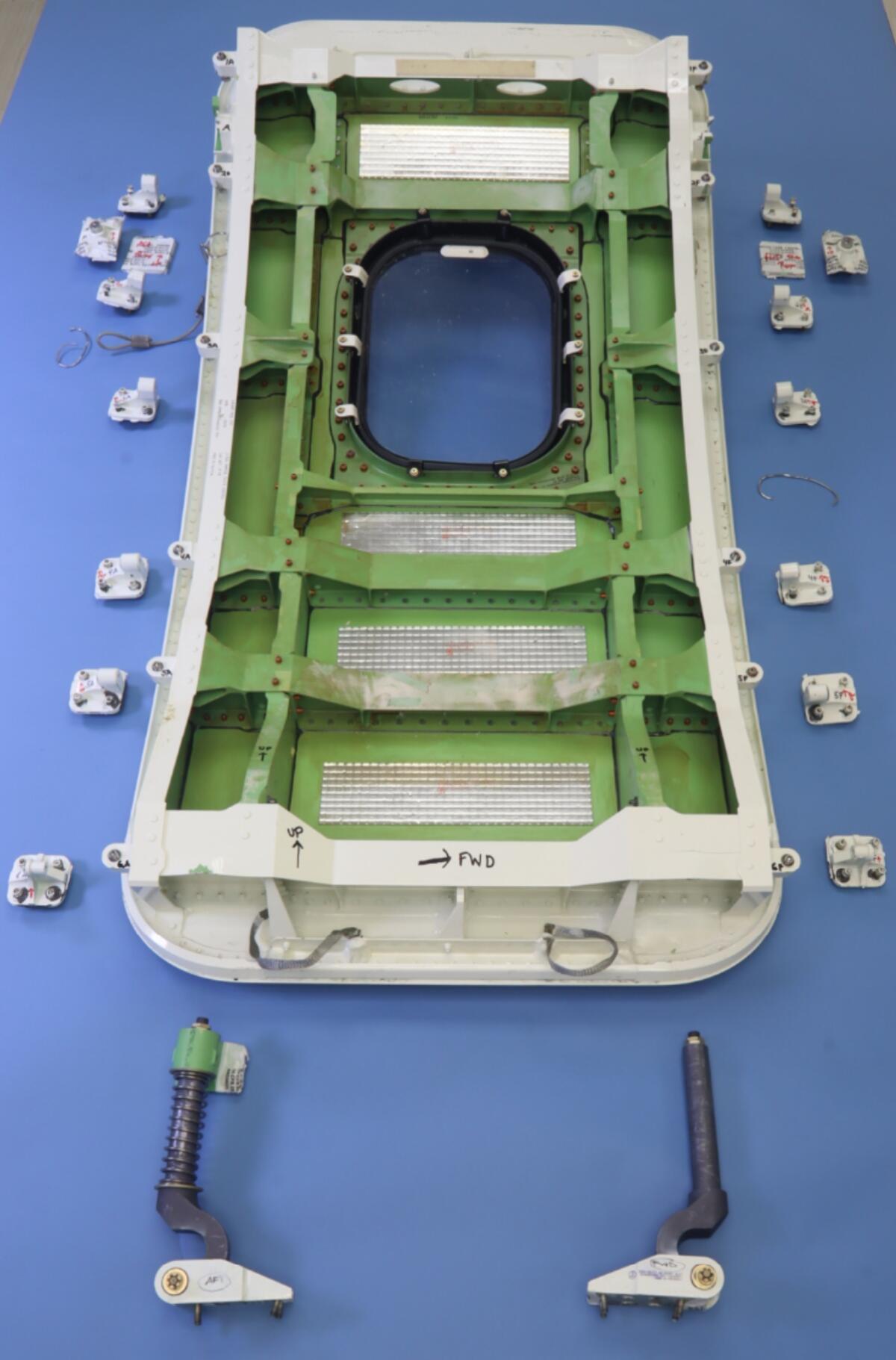
Boeing said in a statement that the company would review the NTSB’s findings “expeditiously” and will continue to “fully and transparently” cooperate with this investigation as well as a separate investigation by the Federal Aviation Administration.
“Whatever final conclusions are reached, Boeing is accountable for what happened,” company Chief Executive Dave Calhoun said in the statement. “An event like this must not happen on an airplane that leaves our factory. We simply must do better for our customers and their passengers.”
What’s a ‘door plug’ and why do airliners have them? How does a smartphone still work after falling three miles? We have answers to these and other questions stemming from Alaska Flight 1282.
Boeing said it has implemented a quality control plan to ensure all 737 Max 9 midexit door plugs are installed “according to specifications,” including new inspections of door plug assembly at both suppliers’ factories as well as in-house, and the addition of “signage and protocol” to fully document when the door plug is opened or removed in the Boeing factory.
Tuesday’s NTSB preliminary report is the latest blow to Boeing and its reputation.
On the same day the report was released, FAA Administrator Michael Whitaker testified before a House subcommittee and suggested that the agency might need to take a heavier-handed approach to monitoring Boeing after the door panel incident.
“One, what is wrong with this airplane? But two, what’s going on with the production at Boeing?” Whitaker told a House subcommittee, according to the Associated Press. “There have been issues in the past. They don’t seem to be getting resolved, so we feel like we need to have a heightened level of oversight.”
Adding to the company’s problems, on Sunday, the aircraft manufacturer said major fuselage supplier Spirit AeroSystems reported that two holes were incorrectly drilled into the window frames of some 737 Max planes.
Boeing said that it was finalizing “rework instructions” for affected planes and that it would make sure that any planes not yet delivered to customers would be in line with specifications.
Joan and Gilbert Marin were traveling home aboard a Boeing 737 Max 9 on Alaska Airlines when they heard a loud explosion and saw a gaping hole in the side of the plane.
Boeing said the issue did not have an “immediate safety-of-flight impact” and that the planes could continue to operate safely.
Last week, Boeing reported a quarterly loss of $30 million, which was less than analysts had expected for the three months that ended Dec. 31, before the door plug blowout. The company said it would not offer a planned forecast of revenue for this year.
“While we often use this time of year to share or update our financial and operational objectives, now is not the time for that,” Calhoun said during a conference call with Wall Street analysts. He added that he was focused on quality control after the door plug incident.
These recent incidents come just a few years after two crashes of 737 Max 8 planes in 2018 and 2019 that killed 346 people. The crashes were largely caused by a faulty automated flight control system.
A set of stairs may have never caused so much trouble in an aircraft.
Although the NTSB’s preliminary report does not reach conclusions about what caused the door plug failure, former Boeing senior manager Ed Pierson, who retired in 2018 from the aircraft giant’s 737 factory, said investigators need to focus on whether there are systemic problems with Boeing’s manufacturing procedures.
“It isn’t somebody missing a bolt,” he said. “It’s typically a breakdown in processes, or it could be just human error. But I would argue that the most likely scenario is that employees felt rushed, and employees were feeling rushed because the corporation is pressuring the factories to produce these planes and pump them out the door.”
Pierson, who also serves as executive director of the watchdog group Foundation for Aviation Safety, said Boeing’s promises to fix the door panel problems ring hollow because he views them as reactive, rather than proactive, measures.
“All of that should have happened a long, long time ago,” he said, referring to the earlier problems with the 737 Max line. “They’re not getting any credit for doing what they should have done years ago.”
The NTSB said its investigation into Alaska Airlines Flight 1282, which was traveling Jan. 5 from Portland International Airport to Ontario, is ongoing.
The plane’s cabin suddenly depressurized as the door plug blew out, leaving a gaping hole in the side of the plane as the aircraft was 16,000 feet in the air. (The door plug was later found in the backyard of a Portland teacher.)
After the door panel was blown out of the plane, the aircraft made an emergency landing back in Portland. Seven passengers and one flight attendant had minor injuries, the NTSB said. The FAA grounded all of the Max 9 planes for nearly three weeks after the incident.
The FAA then grounded all 171 Max 9 aircraft with door plugs, forcing airlines such as United and Alaska to make changes to their flight schedules.
The FAA said Monday that United and Alaska have now inspected and returned to service almost 94% of the two fleets’ Max 9 aircraft, according to Reuters.
More to Read
Inside the business of entertainment
The Wide Shot brings you news, analysis and insights on everything from streaming wars to production — and what it all means for the future.
You may occasionally receive promotional content from the Los Angeles Times.
